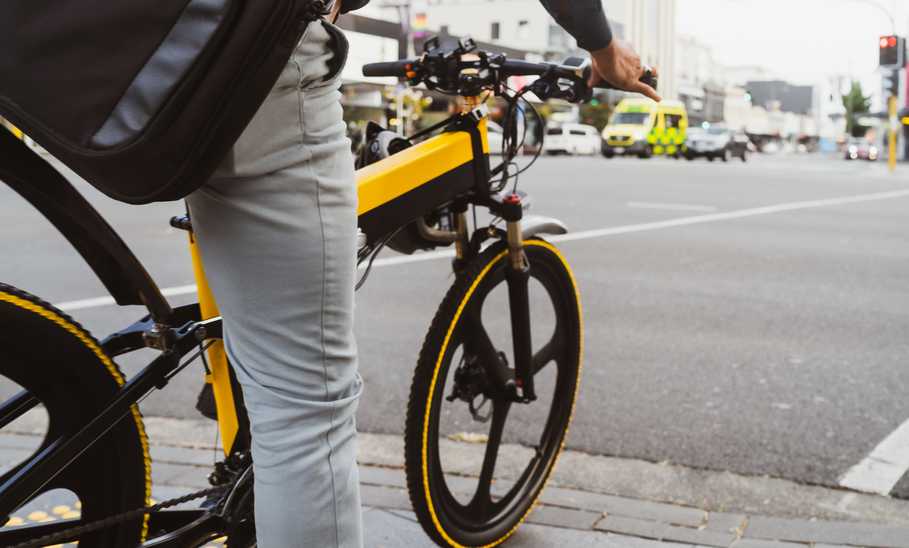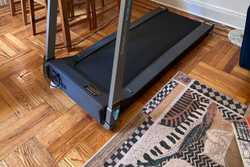How Fast Do Electric Bikes Go? A Complete Guide

Our evaluations and opinions are not influenced by our advertising relationships, but we may earn a commission from our partners’ links. This content is created by TIME Stamped, under TIME’s direction and produced in accordance with TIME’s editorial guidelines and overseen by TIME’s editorial staff. Learn more about it.
Electric bikes are great for taking some of the pain out of pedaling, but don’t expect to go all fast and furious. With a legally mandated top speed of either 20 mph or 28 mph (depending on the class of bike), they’re designed to help you get where you’re going, but not to break the speed limit while doing so—and this is true of all types, from fat tire e-bikes to folding e-bikes or anything in between. So, read on to familiarize yourself with some of the laws around e-bikes and speeding, plus the consequences of going too fast.
“Class 1 electric bikes have a maximum speed of 20 mph and the electric motor only provides power when you pedal,” explains Tyler Swartz, co-founder of E-Bike Commuting. “Some may have a throttle or ‘boost’ button, but it only applies that boost when you’re pedaling. This class is good for someone new to e-bikes that’s looking to get a little added boost on their ride, but don’t need to go super fast.”
“Class 2 electric bikes also have a maximum speed of 20 mph,” says Swartz. “The electric motor provides power when you pedal, or when you use the throttle without pedaling. In my opinion, this is the perfect class—it’s great for beginners, and it’s nice to have a throttle for when you need to get started at a red light or on a hill.”
“Class 3 electric bikes have a maximum speed of 28 mph,” Swartz explains. “There are more restrictions on their use, varying by U.S. state. Some states allow a throttle on Class 3 e-bikes, while others do not. This class is good for an experienced rider who’s familiar with e-bikes and looking to ride their e-bike on busier roads.”
For more info about the different classes of bikes, read our guide to how to choose an electric bike.
“Motor power (measured in watts) directly affects acceleration, i.e., how quickly the electric bicycle reaches a certain speed—it does not affect top speed, which is set by the motor controller,” says Matt Moore, policy counsel at PeopleForBikes. “For example, both a 250-watt and 750-watt motor can propel an electric bike to the top speed allowed by its respective class (1, 2 or 3). The type of motor (rear hub or mid-drive) also does not affect the speed capability of an electric bicycle.”
“Battery capacity has less impact on speed and more impact on ‘range,’ that is how far you can ride on a single, full charge of the battery,” says Vernon Felton, Canyon US bike product development director and global MTB manager. “The bigger the battery, the more fuel cells and, generally speaking, the greater your riding range.”
“Unless you’re a candidate for the next Tour de France, steep hills are likely the bane of your pedaling existence,” says Felton. “They require more power from you, and they also require more power from your motor and battery. So, if you’re climbing super-steep hills, you’ll wind up relying more on your e-bike’s motor assist, which means that you’ll consume more of the battery's electrical charge. To put it more simply, the more climbing you have to do, the faster you’ll run through battery power.”
“The more you weigh, the harder the motor has to work to help propel you and the more battery power you’ll consume in a given ride,” Felton says. “As for the impact of rider skill level, I’d say that more experienced riders tend to make better use of their bike’s gearing, which reduces drain on the battery and extends the life of your e-bike’s components (such as the chain and the gear cogs). A skilled rider knows that they should shift into lower gears as they begin climbing a hill—this allows them to more easily pedal up the grade and reduces the motor’s effort as well.”
“Most pedal-assist bikes have three or more power modes, which you can select via a handlebar-mounted controller/button,” explains Felton. “When you select a higher power setting, you’re able to ride faster, with less effort. But, of course, that also means you’re using more of the battery’s electrical charge. So, if you zoom around in the most powerful modes, you’ll go faster more easily, but you’ll also get fewer miles per charge.”
“Under federal law (15 U.S.C. § 2085), an electric bicycle is referred to as a ‘low-speed
electric bicycle,’” says Moore. “This is defined as ‘a two- or three-wheeled vehicle with fully operable pedals and an electric motor of less than 750 watts (1 h.p.), whose maximum speed on a paved, level surface, when powered solely by such a motor while ridden by an operator who weighs 170 pounds, is less than 20 mph.’”
“Significantly, this definition provides a maximum assisted speed that an electric bicycle can travel when being powered only by the motor, but does not provide a maximum assisted speed,” Moore continues. “In addition, various state laws regulate the top speed of each of the different classes of electric bicycles. Electric-bicycle operators are also subject to state and local speed limits for public roads and trails.”
“Generally speaking, on off-road trails, e-bike usage (where allowed) is limited to Class 1 bikes (no throttle, 20 mph max speed),” adds Felton. “Some city bike paths are also limited to Class 1. Class 3 (28 mph max motor-assisted speed) are generally legal to ride on city streets, but as always, it pays to check with your local land manager (for trails) or city ordinances (for on-road usage).”
For more information on e-bike laws by state, PeopleForBikes has compiled an extremely useful spreadsheet, which you can see here.
“America’s local, state and federal lands are governed by a veritable alphabet soup of agencies, and each can have their own rules regarding e-bike usage,” explains Felton. “In general, where e-bikes are allowed off road, trail riding is restricted to Class 1 e-bikes. When it comes to riding bike paths or city streets, you need to check your local ordinances. Some bike paths are limited to Class 1—again, it just depends on where you live and ride. It always pays to check out your local land manager’s rules on e-bike usage.”
“Exceeding a state or local speed limit subjects the operator of an electric bicycle to the same penalties as the operator of a motor vehicle: a speeding ticket,” says Moore. “Tampering or altering the speed capability of an electric bicycle (by installing a device to bypass the motor controller or reprogramming the controller) is generally illegal because the resulting vehicle will no longer be within the definition of an ‘electric bicycle’—it will instead be considered a motor vehicle that is not in compliance with state laws requiring registration, licensing, insurance and specific equipment.”
“The Class 1 or Class 3 speed rating, by itself, doesn’t massively impact performance, for most people,” says Felton. “The one exception here is if you’re trying to keep up with traffic in a city setting, where a faster Class 3 bike will help you keep pace with the flow of traffic, which might improve your visibility to motorists.”
“An e-bike is, ultimately, a bicycle, so all the same rules apply when it comes to getting the most out of your purchase,” says Felton. Here are some of his tips:
“Keep the chain lubed and clean from excess grit (that black sludgy stuff that inevitably collects on your chain). Maintain your tires’ air pressure—all tires lose air pressure and go flat over time. Check the suggested tire pressure (it’s listed on your tires’ sidewalls), and re-inflate your tires to that pressure every two or three weeks.” Consider an e-bike tire pressure gauge as essential to your gear as an e-bike lock and helmet.
“Keep track of your battery’s charge level—it can take several hours to fully charge your battery, so if you’re planning to ride tomorrow, today is the perfect time to connect your battery to the charger supplied with your e-bike.”
“You can choose any power mode you prefer when riding your bike—the higher the power mode you select, the less effort you need to put into pedaling to zip along. Just remember that the higher power mode drains the battery more quickly and reduces how far you can ride with the motor assisting you.”
“One rookie mistake that some people make is simply switching their e-bike into the highest power mode whenever they see a hill on the horizon. Remember, instead, to shift into your lower (i.e., ‘easier’) gears on climbs and then, when you want a bit more boost, go ahead and select the motor’s higher power modes. If you simply use the high power modes while you’re in a high gear, you put extra strain on your knees and on your bike’s drivetrain. In short, make use of all those gears on your bike, just like you would if you didn’t have a motor attached.”
“At the risk of sounding like a bore, I think e-bike speed is an interesting topic—particularly as it relates to limiting where you can actually ride such a bike—but when it comes to daily performance, I think maximum speed is a bit overrated,” says Felton. “Is the bike reliable? Is it easy and intuitive to operate? Does it have enough battery capacity to enable you to tackle long distances with complete peace of mind? These are the things that set apart the best electric bikes from bikes that might have a low sales price but are sort of a nightmare to own. Getting a bike with a motor and battery system from trusted and proven brands for e-bikes, such as Shimano or Bosch, is what really sets you up for happiness with your purchase.”
“Again, it comes down to what class of e-bike you buy,” reiterates Felton. “For Class 1 bikes, the motor shuts off once you hit 20 mph (naturally, you can still go faster, but you’ll be doing it all on your own steam). Class 3 bikes, on the other hand, will assist you with motor power up to a max of 28 mph.”
With the exception of Class 3 e-bikes, Moore says that “a device that can exceed 20 mph on motor power alone is not an ‘electric bicycle.’ Under federal vehicle law (NHTSA regulations), a device that can exceed 20 mph on motor power alone is a type of ‘motor vehicle.’ Depending on particular state law definitions, such a vehicle may be a ‘motorized bicycle,’ a moped or a motorcycle, and will be regulated accordingly.” To understand more about how e-bikes differ from other forms of transportation, check out our guide to understanding what an electric bike is.
“Any vehicle with a motor rated at more than 750 watts is by definition not an ‘electric
bicycle,’” corrects Moore. “While some manufacturers, consumers and media may refer to vehicles with excessively powerful motors generically as ‘e-bikes,’ they are clearly not within the definition of an electric bicycle, due to their excessive power and/or speed capability. Such a vehicle is undoubtedly a ‘motor vehicle,’ as discussed above, and most likely a motorcycle subject to all federal and state laws applicable to motorcycles.”
The information presented here is created by TIME Stamped and overseen by TIME editorial staff. To learn more, see our About Us page.



